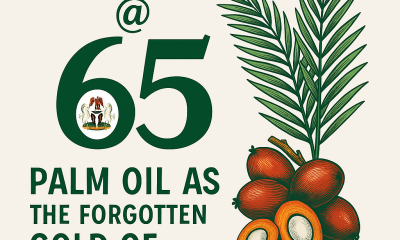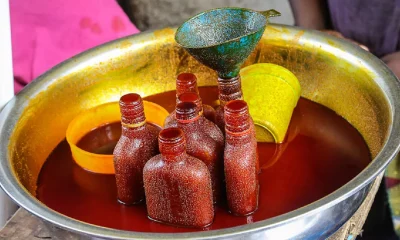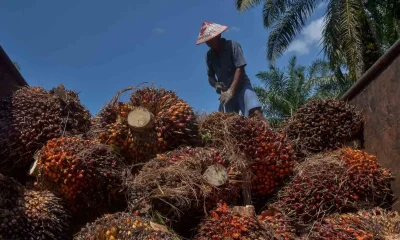Africa PalmOil
Top 10 Palm Oil Producing Countries in Africa — Ranked & Analyzed

Palm oil is one of Africa’s most important agricultural commodities. Used in cooking, cosmetics, biofuels and industrial products, it underpins livelihoods across multiple countries. Yet production is uneven, challenged by infrastructure, regulation, climate, and market access. In this article, we rank the top 10 palm oil producing countries in Africa, analyze what influences their output, and explore what the future looks like.
🇳🇬 1. Nigeria
Production & Statistics
- In 2023, Nigeria produced around 1.4 million metric tons of palm oil. Statista
- Meanwhile, domestic consumption in the 2023/2024 crop year was estimated at 1.9 million metric tons, higher than production, leading to importation to fill the gap. Statista
Drivers & Challenges
- Nigeria’s favorable climate (rainfall, humidity) and large areas of arable land make it naturally competitive.
- However, it faces issues like low mechanization, poor infrastructure for processing mills, weak supply chain for fresh fruit bunches (FFBs), and challenges in value add-processing.
- Policy swings and inconsistent government support also affect investors’ and farmers’ confidence.
Outlook
With targeted investments in smallholder support, better yields, and more efficient mills, Nigeria has the potential not just to maintain its lead in Africa, but significantly increase export volumes. But bridging the gap between production and consumption remains a priority.
🇨🇮 2. Côte d’Ivoire (Ivory Coast)
Production & Statistics
- Côte d’Ivoire is Africa’s second largest producer of crude palm oil (CPO). Forecasts for 2024/2025 put production at 620,000 metric tons (a slight upward revision from earlier estimates of ~600,000). FAS USDA
- The country has had production exceeding 500,000 metric tons in recent years. FAS USDA
Drivers & Challenges
- Expanding smallholder plantations have contributed to this growth. Improvement in data collection has led to more accurate accounting of yields. FAS USDA+1
- Key challenges include ensuring that mills meet regulatory compliance, improving quality of FFBs, and satisfying both domestic demand and export potential. There is strong local demand for palm oil — Côte d’Ivoire uses most of its production domestically. FAS USDA
Outlook
Ivory Coast’s government has been implementing reforms (closing non-compliant mills etc.) and pushing for sustainable practices. If these continue, Côte d’Ivoire could edge closer to Nigeria, especially by improving yield per hectare and downstream processing.
🇨🇲 3. Cameroon
Production & Statistics
- Cameroon is a consistent third among Africa’s largest producers. Its production is estimated at about 465,000 metric tons. Legit.ng – Nigeria news.+2africapalmoil.com+2
Drivers & Challenges
- Cameroon benefits from both plantation and smallholder production systems. A relatively favorable climate and availability of land help.
- However, infrastructure (mills, roads), access to finance, and environmental concerns (deforestation, land use) are constraints. Additionally, getting fresh fruit bunches from remote farms to mills in good condition remains a logistical hurdle.
Outlook
If Cameroon can invest in better processing infrastructure, improve supply chain logistics, and enforce environmental safeguards, it’s poised to grow. Expansion of sustainable palm oil and better governance could make it a more competitive producer globally.
🇬🇭 4. Ghana
Production & Statistics
- Ghana’s palm oil output is estimated around 300,000 metric tons. Legit.ng – Nigeria news.+2africapalmoil.com+2
Drivers & Challenges
- Ghana’s government has declared palm oil a strategic crop; recent investment incentives include subsidies, extension services, and support for smallholders.
- Yet constraints are similar to peers: limited mechanization, processing capacity, disease/ pest pressures, and degraded yields due to overuse of old palm stands and lack of inputs (fertilizer etc.).
Outlook
With renewed policy focus and private sector participation in plantation and processing, Ghana has room to increase both quantity and quality. Also, integrating sustainability (e.g. certification, deforestation-free supply) could open export premium markets.
🇨🇩 5. Democratic Republic of the Congo (DRC)
Production & Statistics
- The DRC is estimated to produce around 300,000 metric tons of palm oil. Legit.ng – Nigeria news.+1
Drivers & Challenges
- Abundant land, favorable agro-climatic zones, and large rural labor force offer potential.
- But political instability, lack of infrastructure (mills, roads), limited private investment, and low yield per hectare (due to old trees, lack of improved planting material) hold the country back.
Outlook
Given its potential land reserve and favourable conditions, growth is possible if political risk can be managed and support for small and medium farms boosted. International partnerships could help build processing capacity.
🇸🇱 6. Sierra Leone
Production & Statistics
- Sierra Leone’s palm oil production is estimated at 75,000 metric tons. Legit.ng – Nigeria news.+1
Drivers & Challenges
- Many smallholders dominate the system; commercial plantation scale is limited.
- Challenges include post-harvest losses, limited milling capacity, lack of access to improved seedlings, weak finance infrastructure.
Outlook
With investment in better seedlings, extension services, and improved mills, Sierra Leone could see substantial growth. Also, diversifying markets and boosting quality (for exports) will be key.
🇦🇴 7. Angola
Production & Statistics
- Angola produces about 55,000 metric tons of palm oil. Legit.ng – Nigeria news.+1
Drivers & Challenges
- Angola’s palm oil industry is relatively underdeveloped compared to West Africa.
- Issues include recovering from past conflicts (which damaged infrastructure), limited investment, and weak policy frameworks. Also, overlapping land rights and environmental concerns complicate expansion.
Outlook
If Angola can establish clearer land and investment policies, and build infrastructure (mills, roads), it could increase production. It may benefit from learning from neighbouring country models (Cameroon, Côte d’Ivoire).
🇬🇳 8. Guinea
Production & Statistics
- Guinea produces an estimated 50,000 metric tons. Legit.ng – Nigeria news.+1
Drivers & Challenges
- Agro-climatic conditions are favorable in many parts, but production is fragmented and largely done by smallholders.
- Infrastructure, access to inputs, processing capacity, and market access are weak. Also, governance and land rights can pose barriers.
Outlook
With foreign investment, particularly in processing and supply chain, Guinea could become more significant in the regional palm oil map. There’s potential for growth in both quantity and quality.
🇱🇷 9. Liberia
Production & Statistics
- Liberia produces approximately 45,000 metric tons of palm oil. Legit.ng – Nigeria news.+1
Drivers & Challenges
- Large areas of land, favorable climate; yet, much of the production remains informal, smallholder, and subsistence or local sale.
- Weak infrastructure (transport, mills), limited capital, land tenure issues, and concerns about environmental sustainability hinder scaling.
Outlook
If Liberia can secure better investment, formalize more of its palm oil sector, and build processing infrastructure, it has opportunity to increase its share. Sustainable branding could also help in accessing higher value markets.
🇸🇳 10. Senegal
Production & Statistics
- Senegal is the 10th in this ranking, producing around 14,000 metric tons. Legit.ng – Nigeria news.+1
Drivers & Challenges
- Senegal’s palm oil production is nascent; many producers are small scale, with limited access to inputs or improved planting materials.
- Also, palm oil is not always the principal crop, so it lags in policy attention relative to peanuts, millet, etc.
Outlook
For Senegal to climb up, deliberate policy measures will be needed: incentives to expand acreage, improved seedlings, public-private partnerships for mills, and investment in processing capacity. Diversification of uses (cooking, biofuel) could help demand.
📊 Comparative Insights
| Country | Estimated 2023/2024 Production (metric tons) | Dominant Production System | Key Constraints |
|---|---|---|---|
| Nigeria | ~1,400,000 | Mixed: large plantations + many smallholders | Infrastructure, yield, processing |
| Côte d’Ivoire | ~600,000-620,000 | Smallholders + emerging plantations | Mill compliance, domestic demand, quality control |
| Cameroon | ~465,000 | Both plantation and smallholder | Logistics, environmental concerns |
| Ghana | ~300,000 | Smallholders, some estates | Old palms, input cost, mechanization |
| DRC | ~300,000 | Smallholder-dominated | Politics, infrastructure, low yields |
| Sierra Leone | ~75,000 | Smallholder | Post-harvest losses, processing gaps |
| Angola | ~55,000 | Underdeveloped estate/smallholder mix | Investment, policy, land rights |
| Guinea | ~50,000 | Mostly smallholders | Infrastructure, seedlings, market access |
| Liberia | ~45,000 | Smallholder | Capital, processing, formalization |
| Senegal | ~14,000 | Small scale | Input, scale, attention/policy |
🌱 What Explains the Differences?
- Land & Climate
Countries with large swathes of suitable land (humid tropics) naturally do better. Fisher-lines between where palm thrives and where it doesn’t matter. - Smallholder vs Estate Balance
Smallholders often have lower yields due to old palms, lack of inputs, and less access to technical support. Estates tend to have higher yield per hectare, better processing, and more consistent supply. - Processing Capacity & Infrastructure
Having mills close to farms reduces losses in transporting FFBs. Roads, reliable energy, and storage matter a lot. - Government Policy, Regulation & Investment
Countries with clear regulatory regimes, incentives for investment and support for smallholders tend to perform better. Also, compliance standards (environment, labour) are more important as global markets demand certified/sustainable palm oil. - Domestic Demand vs Exports
Some countries produce largely for local consumption (Nigeria, Côte d’Ivoire). Export-oriented producers can gain more value but face stricter quality and regulatory hurdles. - Sustainability & Environmental Constraints
Deforestation, land rights, environmental pushback, and sustainability certifications influence which countries can scale sustainably. Those ignoring these factors risk regulatory or consumer backlash globally.
🔮 Future Trends & Implications
- Yield Improvement: Many of the top producing countries could double yield per hectare by replanting old palms, better seedlings, and better agronomic practices (fertilizers, pruning, pest control).
- Value Addition: Processing (refining, fractionation) locally rather than exporting crude palm oil brings larger margins, creates jobs, and builds industry resilience.
- Sustainability Pressure: Global buyers increasingly demand deforestation-free, carbon-neutral, or socially responsible palm oil. Producers who don’t adapt may lose access to key markets (e.g. EU, UK).
- Investment & Finance: Private sector, impact investors, and possibly climate finance will be increasingly attracted to palm oil projects that combine yield, sustainability, and social impact.
- Policy & Governance: Stability, land rights clarity, and efficient regulation make a big difference. Countries that improve these will likely leapfrog.
✅ Conclusion
Nigeria remains the African powerhouse in palm oil production, followed by Côte d’Ivoire and Cameroon. But even countries further down the list (Ghana, DRC, Liberia, etc.) show strong potential, particularly if they address infrastructure bottlenecks, upgrade processing capacity, improve yield, and respond to sustainability demands.
For stakeholders (governments, investors, farmers, and buyers), the growth opportunities are clear—but so are the challenges. The next decade will likely see shifts in ranking as countries that invest carefully in yield, policy, and sustainability begin to reap rewards.





























